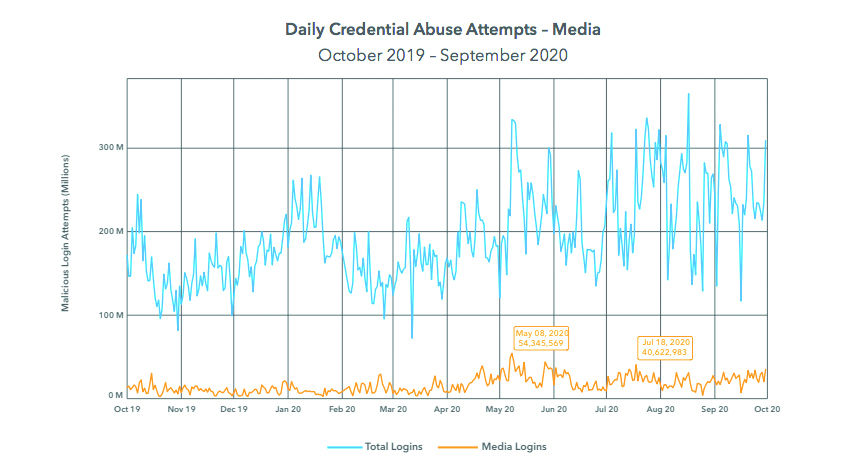Staying One Step Ahead of Video Piracy
How are media companies dealing with piracy in the age of COVID?

LONDON—An event that may have gone unnoticed last December when the U.S. election was still dominating the news cycle, was the ratification of the “Protecting Lawful Streaming Act,” which makes stealing video streams a felony, to be treated the same as illegally distributing copyrighted TV and movies.
And not a moment too soon—Q1 2020 saw a fourfold year-on-year rise in credential stuffing attacks against the media industry, according to a study by Akamai, which reported approximately 100 million malicious login attempts per day.
LOCKING DOWN STREAMS
Clearly the pandemic has a role to play, since lockdowns ironically result in more breaches of streaming security as a result of higher demand. Two months into lockdown last year, Nielsen reported that Americans were streaming twice as much content as in 2019.
“Much of that traffic was driven by more people staying at home relying on streaming video for entertainment,” confirms Ian Munford, director of Media Product Marketing at Akamai. “In our '2020 State of the Internet/Credential Stuffing in the Media Industry' report, we noted a spike in malicious login attempts against European video service providers and broadcasters that coincided with early lockdowns in the region.
“While we can’t definitively state that the attempts were directly related to an increased demand for streaming, it’s certainly reasonable to draw at least some level of correlation between the two,” he continued. “Like many others, criminals were isolating at home as well, and likely had more inclination and time to devote to nefarious activities.”
Philip James, partner, privacy and security from law firm Eversheds Sutherland, concurs. “The appetite for entertainment remains high, and despite the pandemic, is supported by ease of access through mobile and tablets,” he said. “In addition, bandwidth and speed of streaming have increased, and on balance, have become proportionately better value.”
Add to this today’s trend for film companies to release movies online that would traditionally have been tentpole theatrical events, and the seas of piracy grow even choppier.
Get the TV Tech Newsletter
The professional video industry's #1 source for news, trends and product and tech information. Sign up below.
“The increasing proliferation of high-profile content, which would have ordinarily gone to theatrical release, is particularly attractive and some studios have decided to go straight to online stream rather than await theatrical release—with the exception of the Bond franchise, of course, which delayed its release of ‘No Time To Die’ twice as a result of the pandemic," James said. “One of the key reasons for awaiting theatrical release is likely to be security concerns around pirate copies of streamed content.”
Indeed, Warner Bros’ release of “Wonder Woman 1984” directly onto HBO Max made it the target of 10% of all illegal TV or movie downloads on the day it came out, according to piracy tracker TorrentFreak. Writing in Quartz, Adam Epstein estimates “at least $20 million in lost revenue for the studio—and likely much more in subsequent weeks.” This places film studios in a position TV broadcasters have been in for decades, fending off pirates as tenacious as any foe of Wonder Woman.
In 2021 Warner Bros is releasing all of its movies on HBO Max concurrently with their theatrical (and at the moment highly theoretical) release, leaving the company open to digital attacks and, depending on the appetite for the new "Space Jam" movie, losing millions in potential revenue.
SHIELDING CONTENT
How then do broadcasters protect their content from the increasing threat of piracy?
“Regardless of the scope, authentication and encryption are the keys,” said Wayne Pacena, director of engineering, Texas A&M University, KAMU FM & TV, adding that “the implementation is likely very different based upon the scope or context of what is being protected.”
For instance, as sports rights holders up their defense game, pirates respond with equally sophisticated lines of attack.
“During one particular sports tournament, Akamai anti-piracy specialists identified attack vectors changing on a daily and even hourly basis,” notes Munford. “It is for this reason that the means of protection against video piracy also needs to change. No longer is it possible to use one technology such as digital rights management or even watermarking as video pirates will find a way to circumnavigate the protection.

“Responsible broadcasters are now looking to build protection throughout their value chain and adopting a 'zero trust' posture,” Munford added. “In practice, this means stepping up their investigatory and legal activities but also complementing this work by preventing access to internal production systems, preventing credential abuse, protecting APIs in addition to investing in real-time monitoring and stream revocation technologies.”
A SEACHANGE IN IP
ST 2110—the Society of Motion Picture and Television Engineers’ standard for video transport over IP—is designed to enable interoperability between different systems when transmitting uncompressed audio and video over an IP network. Pacena emphasizes the difference between this kind of managed private media infrastructure and the public internet, whose “maze of independent interconnected networks … is simply not an appropriate network choice in which to implement SMPTE ST 2110.”
By contrast, Pacena recommends a broadcaster’s IP network infrastructure employ a number of security measures or layers of protection, including “physical security, Ethernet switch port security, network (subnet) segmentation, packet filtering, access control, encryption and authentication.” A robust network is crucial to stopping the different forms of piracy increasingly jamming up digital space.
Such attacks are now liable to prosecution as felonies, a welcome step for anti-piracy practitioners but far from exhaustive according to Minal Modha, consumer research lead at Ampere Analysis, who noted the continuing threat to live sports.
“Sports is a good place to look when considering the battle against piracy,” Modha said. “Sport rights holders have been fighting it for years, have pumped large amounts of resources into it and are still facing big issues in tackling it. Pirates are using more advanced technology to stay ahead of the game and the vast number of streams available means that as soon as one is taken down, another replaces it almost instantly.
“With the huge numbers of pirate services available and how lucrative it is, unless the bill results in a large number of prosecutions, I’m not sure it’s going to be a further deterrent,” she added.
